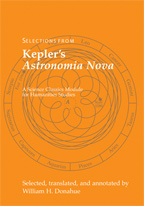Selections from Kepler's Astronomia Nova
A Science Classics Module for Humanities Studies
Selected, translated, and annotated by William H. Donahue
7" x 10", 120 pages, glossary and bibliographical note
Publication date: March 2005.
For pricing and ordering information, see the ordering section below.
 Johannes Kepler wrote Astronomia Nova (1609) in a singleminded drive to sweep away the ancient and medieval clutter of spheres and orbs and to establish a new truth in astronomy, based on physical causality. Thus a good part of the book is given over to a nontechnical discussion of how planets can be made to move through space by physical forces. This is the theme of the readings in the present module.
Johannes Kepler wrote Astronomia Nova (1609) in a singleminded drive to sweep away the ancient and medieval clutter of spheres and orbs and to establish a new truth in astronomy, based on physical causality. Thus a good part of the book is given over to a nontechnical discussion of how planets can be made to move through space by physical forces. This is the theme of the readings in the present module.
The selection features, in the first place, the complete introduction to Astronomia Nova. In this influential essay Kepler gives us his views on the planetary systems debate, ranging over a wide assortment of topics including causes of motions, criteria for choosing one theory over another, gravity and the tides, and the proper relations between science and Scripture. This introduction was Kepler's most widely read work, appended to the Latin editions of Galileo's Dialogue, and translated into the vernacular.
The Introduction is followed by a substantial selection of chapters presenting Kepler's new celestial physics. In Chapter 7, Kepler gives an engaging account of how he came to work on Mars, and why Mars was crucially important to his success. Chapters 33 and 34 will also be of general interest, as they sketch out the arguments for the sun's dynamic role in moving the planets. These chapters are easily understandable and contain no mathematics. For the more adventurous, there is a larger sequence that takes us from the basics of planetary motions all the way to Kepler's first two laws of planetary motion. These chapters occasionally require some basic geometry and the use of the sine function. The necessary astronomical information and terminology is provided in appendices and a glossary.
In these ground-breaking chapters, the true Kepler emerges, not as a speculative mystic or a number-crunching drudge, but as a first-rate scientific thinker with a wonderfully engaging narrative style.
Features
- An accessible, fascinating, and inexpensive selection from Kepler's greatest work.
- With minimal mathematics, shows how Kepler proposed to set astronomy on a sound physical foundation.
Review
The translation is quite readable ... Donahue prudently allows Kepler 'the courtesy of supposing that what he writes can be understood' [in Donahue's words], and has managed a translation that preserves a good bit of the style of the Latin: sometimes elevated, frequently jocular, on occasion impassioned. The English almost always seems faithful in tone to the original.
— Bruce Stephenson
Isis
(Isis is the journal of the History of Science Society, published by the University of Chicago Press).

